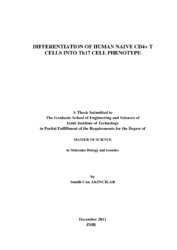Please use this identifier to cite or link to this item:
https://hdl.handle.net/11147/3177Full metadata record
| DC Field | Value | Language |
|---|---|---|
| dc.contributor.advisor | Nalbant Aldanmaz, Ayten | en |
| dc.contributor.author | Akıncılar, Semih Can | - |
| dc.date.accessioned | 2014-07-22T13:51:01Z | - |
| dc.date.available | 2014-07-22T13:51:01Z | - |
| dc.date.issued | 2011 | en |
| dc.identifier.uri | http://hdl.handle.net/11147/3177 | - |
| dc.description | Thesis (Master)--Izmir Institute of Technology, Molecular Biology and Genetics, Izmir, 2011 | en |
| dc.description | Includes bibliographical references (leaves: 25-32) | en |
| dc.description | Text in English; Abstract: Turkish and English | en |
| dc.description | x, 32 leaves | en |
| dc.description | Full text release delayed at author's request until 2015.01.26 | en |
| dc.description.abstract | Th17 cells are recently identified CD4+ T cell subset and best defined as their secretion of IL17, an inflammatory cytokine, and their role in host defense and autoimmunity. Further information on Th17 cell subset is strongly correlated with the differentiation and maintenance of these cells in culture. Although the master regulators and culture conditions in mouse Th17 differentiation are defined, the requirements and maintenance of human Th17 cell cultures remain unclear. Here, we suggest a new culture condition that maximizes IL17 expression and gives minimum IL17+IFNg+ and IL17+Foxp3+ among human studies. Our data define the doses and combinations of various cytokines that rise IL17 expression, as well as regulatory molecules in human Th17 cell differentiation. Various combinations of cytokines reveal that IL1β is the most important cytokine that primes Th17 differentiation. Also it was observed that TGFβ positively regulates Th17 differentiation in a dose-dependent manner by inhibiting IFNγ expression thus represses Th1 differentiation and impairs Treg polarization at transcription factor state by tightly regulating Foxp3. Although it was suggested that Th17 cells must express RORC2, the master regulator, a minor cell population that expresses IL17, but does not co-express RORC2 was observed. | en |
| dc.language.iso | en | en_US |
| dc.publisher | Izmir Institute of Technology | en |
| dc.rights | info:eu-repo/semantics/openAccess | en_US |
| dc.subject | T lymphocytes | en |
| dc.subject | Cellular pathways | en |
| dc.subject.lcsh | T cells | en |
| dc.subject.lcsh | Th1 cells | en |
| dc.subject.lcsh | Th2 cells | en |
| dc.title | Differentiation of human naive CD4+T cells into Th17 cell phenotype | en_US |
| dc.type | Master Thesis | en_US |
| dc.institutionauthor | Akıncılar, Semih Can | - |
| dc.department | Thesis (Master)--İzmir Institute of Technology, Molecular Biology and Genetics | en_US |
| dc.relation.publicationcategory | Tez | en_US |
| item.fulltext | With Fulltext | - |
| item.grantfulltext | open | - |
| item.languageiso639-1 | en | - |
| item.openairecristype | http://purl.org/coar/resource_type/c_18cf | - |
| item.cerifentitytype | Publications | - |
| item.openairetype | Master Thesis | - |
| Appears in Collections: | Master Degree / Yüksek Lisans Tezleri | |
Files in This Item:
| File | Description | Size | Format | |
|---|---|---|---|---|
| 421419.pdf | MasterThesis | 1.75 MB | Adobe PDF |  View/Open |
CORE Recommender
Page view(s)
200
checked on Nov 18, 2024
Download(s)
104
checked on Nov 18, 2024
Google ScholarTM
Check
Items in GCRIS Repository are protected by copyright, with all rights reserved, unless otherwise indicated.